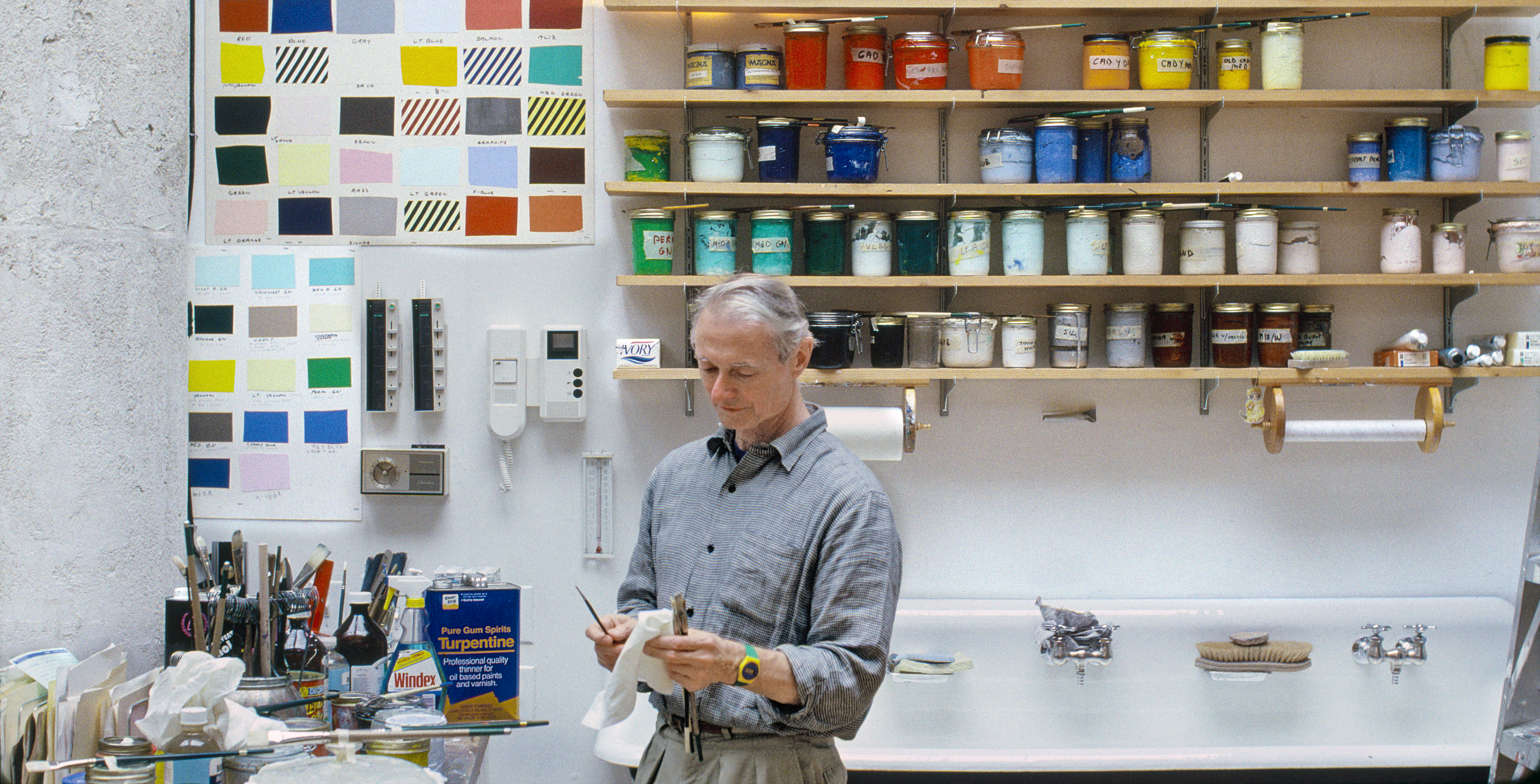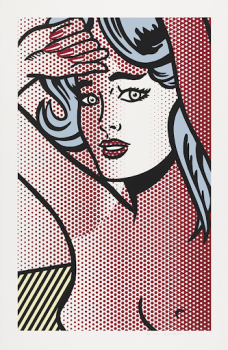
Nudes and Icons: Roy Lichtenstein's Most Cherished Works
A titan of the twentieth century and vanguard of Pop, Roy Lichtenstein was an iconic and unparalleled force in the development of Contemporary Art, responsible for shaping its form, content, meaning, and future. Charting three decades, the selection of works from The Collection of Dorothy and Roy Lichtenstein encapsulates an unprecedented survey of Lichtenstein's practice. This exquisite suite provides a rare glimpse into the artist's process and artistic development, which was so often concealed in his compositions. Masterfully fusing canonical art historical references and contemporary mass media, Lichtenstein deconstructed the arbitrary boundaries between "high" and "low," offering the world a new window into our reality through an innovative and instantly recognizable visual lexicon. Lichtenstein's Ben-Day dots and comic-like aesthetic have become synonymous with Pop and Contemporary Art. Consisting of collage, sculpture, drawings, and prints, this selection from Roy and Dorothy's collection captures Lichtenstein's artistic development across media and time, commemorative of a golden age in Contemporary Art.


A pioneer of Pop Art, artist Roy Lichtenstein needs little introduction. His iconic comic book, Ben-Day dot lined aesthetic, has become synonymous with the genre, which first emerged in the 1950s and flourished throughout the following decade. Embracing popular culture and mass media, Lichtenstein, along with contemporaries such as Andy Warhol and Keith Haring, rebelliously rejected the notion that fine art must be dependent upon the pillars of inaccessibility and traditionalism. Emerging out of Abstract Expressionism, which largely explored painterliness and psychological introspection, Pop Art valued mass media and universalism instead. Consisting of collage, sculpture, drawings, and prints, this selection from Roy and Dorothy's coveted personal collection captures Lichtenstein's artistic development across media and time, commemorative of a golden age in Contemporary Art.
A radiant portrayal of exquisite beauty, Roy Lichtenstein’s Nude with Bust (Study) from 1995 constitutes the ultimate crystallization of the artist’s enduring engagement with the quintessential heroine of his inimitable oeuvre. Impeccably realized and wholly complete on its own, Nude with Bust (Study) serves as the preliminary collage for the large-scale final painting of the same name and composition, and a paradigmatic example of the broader series of Nudes which became the fixation of Roy Lichtenstein’s practice in the mid-1990s. At its core, the series took as its focus the reformulation of the canonical female nude, a motif which has served as an iconographic cornerstone throughout the evolution of art history, and indeed throughout the evolution of Lichtenstein’s own artistic practice as well. The present composition is distinguished by its inclusion of two female figures: one seated female nude, and the other a female bust based on the model beside it. In this iconic interior scene, Lichtenstein places a bust on a pedestal, perhaps implying the space as a studio, thus once again interacting with an quintessential motif of the artist portraying their studio that has pervaded the Western art tradition. By nature of their source and the history of the theme more broadly, both the bust and the seated nude within the present work serve as self-conscious reappropriations of a long-appropriated motif. The result is a playful yet ultimately transgressive reconsideration of the art historical approach to the female nude, one that places Lichtenstein into dialogue with the weighty mantle of his artistic predecessors, while also cementing his own ultimate grand contribution to Contemporary Art.

“[Roy] really took time. He loved being in the studio. He was pretty regular to get down there. He really always managed to be down in the studio by 10 because people would come to work. Although, at that time, he only had one assistant and a kind of secretary, he was really willing to put in the time.

Whereas in earlier works, Lichtenstein’s ubiquitous dots were uniform in their size and spacing and were meticulously contained within the boundaries of a single object or outline, in Nude with Bust (Study), they here take on a more dynamic character. Freed from their figurative obligation, they instead come to communicate and schematize these emotive qualities of light. The black dots are here applied in bands which undulate according to their gradation of density, and so emulate the effect of a shadow over the areas they cover. Executed in the twilight of his storied life and career, Nude with Bust (Study) offers an exceptional late example of Lichtenstein’s inimitable artistic process and incisive stylistic eye. Replete not only with art historical referent, the present work also sees Lichtenstein reflect on his own artistic career: for example, Lichtenstein includes in the present composition a painted version of two of his sculptures, Woman: Sunlight, Moonlight and Endless Drip, the latter of which was inspired by Constantin Brancusi’s Endless Column. And even beyond these explicit allusions to his broader oeuvre, Nude with Bust (Study) serves as a poignant self-portrait of the artist himself in style as in subject matter, a realization that is further reinforced by the medium itself. The physical construction of the collage serves as a remarkable insight to and record of Lichtenstein’s artistic process.


Sotheby's presentation of Works from the Collection of Dorothy and Roy Lichtenstein also includes the artist's rendition of Constantin Brancusi's Sleeping Muse. As a consummate example of Roy Lichtenstein’s masterful engagement with and reorientation of the art historical canon, Sleeping Muse from 1983 at once beautifully evokes and radically advances Constantin Brancusi’s paradigmatic Sleeping Muse from 1910. Composed of elegantly refined contours which enclose a void, Sleeping Muse achieves a sense of volume precisely through the absence of mass, probing the boundaries of the discipline of sculpture. Capturing the essence of Brancusi’s form with bold lines which evoke those of mid-century comic strips, Lichtenstein fuses the visual vernacular of pop culture with an iconic symbol of Modernism. Appearing first at Leo Castelli Gallery’s celebrated exhibition, Roy Lichtenstein: Paintings; Greene Street Mural, 1983-1984, the present work has been widely exhibited around the world, including the most significant exhibition of the artist’s lifetime: Roy Lichtenstein: A Retrospective, organized by the Solomon R. Guggenheim Museum and traveling internationally.

Lichtenstein's embrace of Modern masters continues with his exceptional Still Life with Picasso. An arresting composition of bold colors and compacted forms, Still Life with Picasso (Study) is an extraordinary embodiment of Roy Lichtenstein’s career-long engagement with one of the most significant art historical icons of the twentieth century, Pablo Picasso. Executed as a response to Picasso’s passing in 1973, Lichtenstein created the present work as a study for a series of prints, Still Life with Picasso, which he contributed to a six-volume celebration of the late Cubist master and his work. Unquestionably one of Lichtenstein’s foremost influences, the thread of Picasso’s legacy is vitally and intimately woven throughout Lichtenstein’s storied career – as exemplified by Still Life with Picasso (Study), Lichtenstein continuously reimagined and recontextualized Picasso’s imagery within his own works, reveling in his ever-expanding Pop lexicon and ultimately painting himself into art history through appropriation. Testifying to significance of the present work, Still Life with Picasso (Study) has been exhibited widely at institutions such as the Centre National d'Art Contemporain, Paris; the Museum of Modern Art, New York; the Museo de Arte Abstracto Español, Cuenca, Spain; and the Nationalgalerie, Staatliche Museen Preussischer Kulturbesitz, Berlin.
Roy's Lichtensteins: Works from the Collection of Dorothy and Roy Lichtenstein presents an extraordinary and succinct survey of the cherished works the couple retained for themselves. Spanning collage, works on paper, and sculpture, this November offers an intimate window into the mind of one of Contemporary Art's most lionized legends. Below, browse highlights to be offered as part of Sotheby's The Now and Contemporary Evening Auction on 20 November 2024, with further works to follow as part of the Contemporary Day Auction on 21 November 2024.























